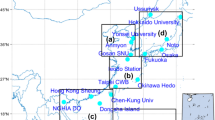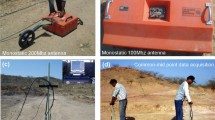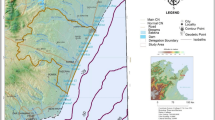Abstract
Coral reefs are one of the most diverse of all marine ecosystems and are often referred to as the “rainforests of the sea”. Though they cover less than one per cent of Earth’s surface, they are home to one quarter of all ocean species by providing food and shelter to them. Optical remote sensing has been widely employed for mapping and monitoring coral reefs. But the application of microwave remote sensing has been an alternate domain in this area. This study explores the possibility of utilizing synthetic aperture radar (SAR) data of Radar Imaging Satellite-I, India’s first indigenous microwave satellite to delineate the coral reefs in Andaman and Lakshadweep Islands in the Indian Ocean. The dual polarized data, after reducing the speckle has been classified to delineate the coral reefs in the vicinity of both islands. SAR has a performance comparable with passive optical sensors under favourable conditions of imaging, viz. optimum tidal current and surface winds. The study results are compared with the international coral reef reference map and are found to be highly promising, with an overall accuracy of 98.3% and a Kappa coefficient of 0.944 for fringing reefs in Andaman region. For the atolls in Lakshadweep region, the overall accuracy is found to be 92.99% and the Kappa coefficient is estimated at 0.7377. This study tries to explore a different horizon for microwave remote sensing in coral reef studies. It is seen that, optical and microwave remote sensing can provide a mutually supporting platform in coral reef delineation, in terms of imaging depth as well as climatic conditions.












Similar content being viewed by others
References
Alpers, W., Campbell, G., Wensink, H., & Zhang Q. (2004). NOAA SAR marine user’s manual, Ch. 10, Underwater Topography. http://www.sarusersmanual.com/
Andaman and Nicobar Tourism. (2015). Govt. of India, About Andaman—General Information and statistics. http://www.andaman.gov.in/
Andaman Islands Tide Chart. (2015). Information on Tide Chart. http://tides.mobilegeographics.com/locations/4865/
Andréfouët, S., Muller-Karger, F. E., Robinson, J. A., Kranenburg, C. J., Torres-Pulliza, D., Spraggins, S. A., & Murch, B. (2004). Global assessment of modern coral reef extent and diversity for regional science and management applications: a view from space. In Proceedings of 10th international coral reef symposium, Okinawa, held at Japan from June 28–July 2, 2004, pp. 1732–1745.
Attakoya, E. P. (2000). Basic statistics of the year 1998–99. Secretariat, Department of Planning and Statistics, Kavaratti, Union Territory of Lakshadweep, pp. 1–257
Benfield, S., Guzman, H., Mair, J., & Young, A. (2007). Mapping the distribution of coral reefs and associated sublittoral habitats in Pacific Panama: A comparison of optical satellite sensors and classification methodologies. International Journal of Remote Sensing, 28(22), 5047–5070.
Biña, R. T., Carpenter, K., Zacher, W., Jara, R., Lim, J. B. (1978). Coral reef mapping using LANDSAT data: Follow-up studies. In Proceedings of 12th international symposium on remote sensing of environment held at Quezon City: Natural Resources Management Center, pp. 2051–2070.
Bour, W. (1988). SPOT mages for coral reef mapping in New Caledonia. In Proceedings of the 6th International Coral Reef symposium held at Australia (Vol. 2).
Bragg, W. L. (1913). The diffraction of short electromagnetic waves by a crystal. Proceedings of the Cambridge Philosophical Society, 17, 43–57.
Coral Vita. (2015). Restoring reefs through accelerated coral farming. Why reef matter. http://www.coralvita.co/whyreefs-matter/
Dadhich, A. P., Nadaoka, K., Yamamoto, T., & Kayanne, H. (2011). Detecting coral bleaching using high resolution satellite data analysis and 2-dimensional thermal model simulation in the Ishigakifringing reef. Coral Reefs, 31(2), 425–439.
Dauphin Island Sea Lab. (2005). Coral Reef Decline—Not just overfishing. Science Daily, 31 August 2005. http://www.sciencedaily.com/releases/2005/08/050830072609.html/
de Rudorff, F., & Gherardi, D. F. M. (2008). Coral Reef detection using SAR/RADARSAT-1 images at Costa dos Corais, PE/AL, Brazil. Brazilian Journal of Oceanography, São Paulo, 56(2), 85–96.
Defenders. (2015) Basic facts about corals. http://www.defenders.org/coral-reef/basic-facts/
Goodman, J. A., Samuel, G. J., Stuart, P., & Phinn, R. (2013). Coral reef remote sensing—A guide for mapping, monitoring and management. New York: Springer.
Green, E. P., Mumby, P. J., Edwards, A. J., & Clark, C. D. (2000). Remote sensing handbook for tropical coastal management. Paris: UNESCO.
Hochberg, E. J., & Atkinson, M. J. (2003). Capabilities of remote sensing to classify coral, algae, and sand as pure and mixed spectra. Remote Sensing Environment, 85, 174–189.
Holden, H., & LeDrew, E. (1998). Hyperspectral identification of coral reef features. International Journal of Remote Sensing, 20(13), 2545–2563.
IMaRS, College of Marine Science, & University of South Florida. (2015). Information on Coral Reef Data base. http://imars.marine.usf.edu/MC/output_indian_ocean.html/
Jet Propulsion Laboratory. (2015). Information on MetOp-A ASCAT Level 2 Ocean Surface Wind Vectors Optimized for Coastal Ocean. http://podaac.jpl.nasa.gov/dataset/ASCATA-L2-Coastal
John, D., Hedley, L., & Roelfsema, C. M. (2016). Remote sensing of coral reefs for monitoring and management: A review. Remote Sensing, 8(2), 118.
Joyce, K. E., Phinn, S. R., Roelfsema, C. M., Neil, D. T., & Dennison, W. C. (2004). Combining LANDSAT ETM+ and reef check classifications for mapping coral reefs: A critical assessment from the southern Great Barrier Reef, Australia. Coral Reefs, 23, 21–25.
Jupp, D. L. B., Mayo, K. K., Kuchler, D. A., Claasen, D. V. R., Kenchington, R. A., & Guerin, P. R. (1985). Remote sensing for planning and managing the Great Barrier Reef of Australia. Photogrammetria, 40, 21–42.
Lehner, S., Pleskachevsky, A. L., Bruck, M., Li, X., & Brusch, S. (2011). Validation of coastal wind and wave fields by high resolution satellite data. In 12th international workshop on wave hindcasting and forecasting held at Kohala Coast, Hawai’i, HI.
Liceaga-Correa, M. A., & Euan-Avila, J. I. (2002). Assessment of coral reef bathymetric mapping using visible Landsat Thematic Mapper data. International Journal of Remote Sensing, 23, 2002.
Lillesand, T. M., & Kieffer, R. W. (1994). Remote sensing and image interpretation. New York: Wiley.
Mason, D. C., & Davenport, I. J. (1996). Accurate and efficient determination of the shoreline in ERS-1 SAR images. IEEE Transactions on Geoscience and Remote Sensing, 34, 1243–1245.
Mumby, P. J., Skirving, W., Strong, A. E., Hardy, J. T., LeDrew, E. F., Hochberg, E. J., Stumpf, R. P., & David, L. T. (2004). Remote sensing of coral reefs and their physical environment. Marine Pollution Bulletin, 48, 219–228.
Newman, C. M., Ledrew, E. F., & Lim, A. (2006). Mapping of coral reefs for management of marine protected areas in developing nations using remote sensing. Remote Sensing and Digital Image Processing, 9, 251–278.
NRSC. (2015). National Remote Sensing Centre, Info on RISAT-1. http://www.nrsc.gov.in/Data_Products_Services_Satellite_RISAT1.html/
Plant, W. J. (1990). Bragg Scattering of electromagnetic waves from the air/sea interface. In G. L. Geernaert & W. J. Plant (Eds.), Surface waves and fluxes (Vol. 2, pp. 41–108). Berlin: Kluwer Academic Publishers.
Pleskachevsky, A., & Lehner, S. (2011). Estimation of underwater topography using satellite high resolution synthetic aperture radar data. In Proceedings of the 4th TerraSAR-X meeting held at Oberpfaffenhofen, Germany from 14 to 16 February 2011 (pp. 1–19).
Smith, E. V., Rogers, R. H., & Reed, L. E. (1975). Automated mapping and inventory of Great Barrier Reefzonation with Landsat data. IEEE Ocean, 1, 775–780.
Stoddart, D. R. (1969). Ecology and morphology of recent coral reefs. Biological Reviews, 44, 433–498.
Union Territory of Lakshadweep. (2015). NIC, Govt. of India. Know Lakshadweep, http://lakshadweep.nic.in/KL_knowLakshadweep.html/
Venkataraman, K., Satyanarayana, Ch., Alfred, J. R. B., & Wolstenholme, J. (2003). Handbook on hard corals of India. Kolkota: Zoological Survey of India.
Wafar, M., & Wafar, S. (2001). 101 questions on corals: Towards awareness. National Institute of Oceanography and Administration of the UT of Lakshadweep. http://drs.nio.org/drs/handle/2264/86
WWF. (2015). World Wide Fund for Nature. http://wwf.panda.org/about_our_earth/blue_planet/coasts/coral_reefs/
Yamano, H., Shimazaki, H., Matsunaga, T., Ishoda, A., McClennen, C., Yokoki, H., Fujita, K., Osawa, Y., & Kayanne, K. (2006). Evaluation of various satellite sensors for waterline extraction in a coral reef environment: Majuro Atoll, Marshall Islands. Geomorphology, 82, 398–411.
Yuvaraj, E., Dinesh Kumar, S., & Dharanirajan, K. (2015). An approach for extracting coral reef environs by interpreting multi-dimensional SAR and multispectral data. Journal of Indian Society of Remote Sensing, 43(3), 617–624.
Zhang, T., Yang, X., Hu, S., & Su, F. (2013). Extraction of coastline in aquaculture coast from multispectral remote sensing images: Object-based region growing integrating edge detection. Remote Sensing, 5, 4470–4487.
Acknowledgements
The coral reference map was based on the data obtained from the Millennium Coral Reef Mapping Project, Institute for Marine Remote Sensing, University of South Florida (IMaRS/USF) and Institut de Recherche pour le Développement (IRD/UR 128, Centre de Nouméa). Thanks are due to IMaRS for providing free download of this highly valuable data.
Author information
Authors and Affiliations
Corresponding author
About this article
Cite this article
Nair, T., James, L., Rao, C.V. et al. A Study on the Delineation of Coral Reefs in Andaman and Lakshadweep Islands Using RISAT-1 Data. J Indian Soc Remote Sens 45, 873–885 (2017). https://doi.org/10.1007/s12524-016-0634-x
Received:
Accepted:
Published:
Issue Date:
DOI: https://doi.org/10.1007/s12524-016-0634-x




